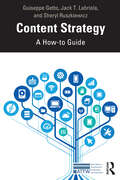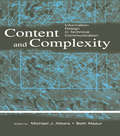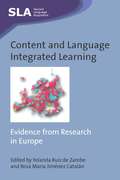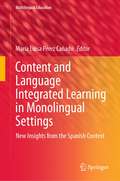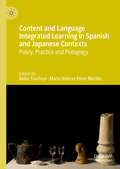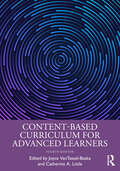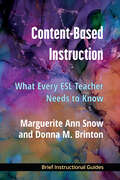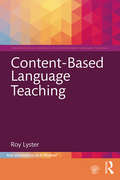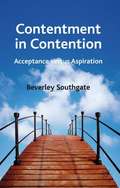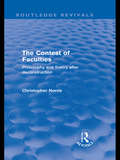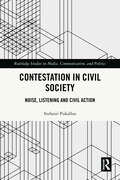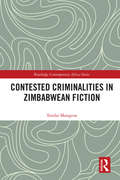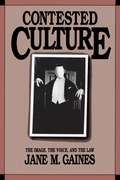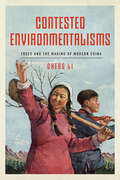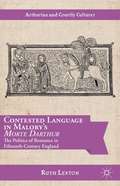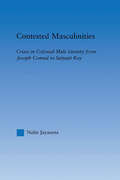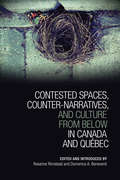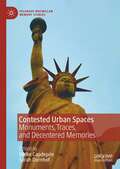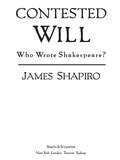- Table View
- List View
Content Strategy: A How-to Guide (ATTW Series in Technical and Professional Communication)
by Guiseppe Getto Jack T. Labriola Sheryl RuszkiewiczThis comprehensive text provides a how-to guide for content strategy, enabling students and professionals to understand and master the skills needed to develop and manage technical content in a range of professional contexts. The landscape of technical communication has been revolutionized by emerging technologies such as content management systems, open-source information architecture, and application programming interfaces that change the ways professionals create, edit, manage, and deliver content. This textbook helps students and professionals develop relevant skills for this changing marketplace. It takes readers through essential skills including audience analysis; content auditing; assembling content strategy plans; collaborating with other content developers; identifying appropriate channels of communication; and designing, delivering, and maintaining genres appropriate to those channels. It contains knowledge and best practices gleaned from decades of research and practice in content strategy and provides its audience with a thorough introductory text in this essential area. Content Strategy works as a core or supplemental textbook for undergraduate and graduate classes, as well as certification courses, in content strategy, content management, and technical communication. It also provides an accessible introduction for professionals looking to develop their skills and knowledge.
Content and Complexity: information Design in Technical Communication
by Michael J. Albers Beth MazurInformation design is an emerging area in technical communication, garnering increased attention in recent times as more information is presented through both old and new media. In this volume, editors Michael J. Albers and Beth Mazur bring together scholars and practitioners to explore the issues facing those in this exciting new field. Treating information as it applies to technical communication, with a special emphasis on computer-centric industries, this volume delves into the role of information design in assisting with concepts, such as usability, documenting procedures, and designing for users. Influential members in the technical communication field examine such issues as the application of information design in structuring technical material; innovative ways of integrating information design within development methodologies and social aspects of the workplace; and theoretical approaches that include a practical application of information design, emphasizing the intersection of information design theories and workplace reality. This collection approaches information design from the language-based technical communication side, emphasizing the role of content as it relates to complexity in information design. As such, it treats as paramount the rhetorical and contextual strategies required for the effective design and transmission of information. Content and Complexity: Information Design in Technical Communication explores both theoretical perspectives, as well as the practicalities of information design in areas relevant to technical communicators. This integration of theoretical and applied components make it a practical resource for students, educators, academic researchers, and practitioners in the technical communication and information design fields.
Content and Language Integrated Learning
by Rosa Maria Jimenez Catalan Yolanda Ruiz de ZarobeThis book contributes to the growth of interest in Content and Language Integrated Learning (CLIL), an approach to second/foreign language learning that requires the use of the target language to learn content. Within the framework of European strategies to promote multilingualism, CLIL has begun to be used extensively in a variety of language learning contexts, and at different educational systems and language programmes. This book brings together critical analyses on theoretical and implementation issues of Content and Language Integrated Learning, and empirical studies on the effectiveness of this type of instruction on learners' language competence. The basic theoretical assumption behind this book is that through successful use of the language to learn content, learners will develop their language proficiency more effectively while they learn the academic content specified in the curricula.
Content and Language Integrated Learning in Monolingual Settings: New Insights from the Spanish Context (Multilingual Education #38)
by María Luisa Pérez CañadoThis book offers new empirical insights into the current state of Content and Language Integrated Learning (CLIL) characterisation (through an innovative proposal to link CLIL to English as a Lingua Franca), implementation (via observation protocols and SWOT analyses), and research (by examining the effects of CLIL on the L1, foreign language, key competences, and content subjects taught through English). The book provides a state of the art of the CLIL arena, identifies the chief challenges that need to be addressed and signposts possible ways of overcoming these in order to continue advancing smoothly into the next decade of CLIL development. This book will be of interest to researchers, policy-makers, educational authorities, and practitioners as it will assist them in making informed decisions about how to characterise, implement, and investigate CLIL in the bi- and plurilingual programs that are more frequently introduced in monolingual contexts.
Content and Language Integrated Learning in South America (Multilingual Education #46)
by Yolanda Ruiz de Zarobe Darío Luis BanegasCLIL is a pedagogical approach which has gained traction in different educational and geographical contexts as a key tool in language learning and teaching. After more than 25 years of implementation, we can assert that we have learned a great deal about what CLIL entails. However, it is also true that we still need to contextualise the approach in order to clearly delimit what CLIL has to offer in each setting. This is precisely the aim of this book. This volume focuses on CLIL in South American contexts. It identifies, clarifies and offers insights into issues related to its characterisation and implementation, as well as teacher education. With contributions from a prestigious array of scholars and practitioners from various parts of South America, it also highlights some of the achievements and challenges in the process of implementing CLIL in the region. Against the backdrop of South American contexts, this book aims to provide a useful and innovative lens through which policy makers, researchers and teachers will find significant implications for the development of CLIL.
Content and Language Integrated Learning in Spanish and Japanese Contexts: Policy, Practice and Pedagogy
by Keiko Tsuchiya María Dolores Pérez MurilloThis edited book compiles pedagogical practices and studies of Content and Language Integrated Learning (CLIL) from two sites: Spain, where CLIL has been widely implemented for more than a decade, and Japan, where the CLIL approach is still in its relative infancy, and quickly gaining momentum. Focusing on three aspects of the CLIL implementations: policy, practice and pedagogy, the authors describe how CLIL has evolved in distinctive socio-political, historical and cultural contexts. The chapters range across primary, secondary and tertiary education, and examine English language teaching and learning at both the macro level - through language education policy - and the micro level - with a focus on classroom interaction and pedagogy. This book fills a gap in the English as a Medium of Instruction (EMI) literature, and will be of particular interest to language teachers, teacher trainers, and students and scholars of applied linguistics more broadly.
Content-Area Writing: Every Teacher's Guide
by Harvey Daniels Steven Zemelman Nancy SteinekeThere are three truths about teaching writing, one that's widely known, one that isn't, and one that will change your teaching forever: the ability to write is essential for students in every subject area writing is the most powerful and efficient tool that teachers have for helping students connect with content and deepen their understanding of it every teacher, including you, is ready to coach middle and secondary writers successfully right now. No matter what subject you teach, Content-Area Writing is for you, especially if you're juggling broad curriculum mandates, thick textbooks, and severe time constraints. It not only shows that incorporating carefully structured writing activities into your lessons actually increases understanding and achievement, but also proves how writing can save, not consume, valuable instructional time. Following up on Subjects Matter - the book that changed how tens of thousands of language arts, math, science, and social studies teachers use reading in their classrooms - Harvey Daniels, Steven Zemelman, and Nancy Steineke now present the most thorough and practical exploration available of writing in the subject areas. Content-Area Writing guides you strategically through the two major types of writing that every student must know: Writing to Learn: the quick, exploratory, and extemporaneous in-class writing that helps kids engage deeply with content, build connections, and retain what they've learned, Public Writing: planned, constructed, and polished writing in which students demonstrate knowledge and reflect on what they've learned. With their contagious combination of humor, irreverence, and classroom smarts, Daniels, Zemelman, and Steineke give you dozens of valuable lessons for encouraging growth in both types of writing with subject-specific ideas for planning, organizing, and teaching, as well as samples of student work and guidelines for evaluation and assessment. They also include detailed information on how their strategies fit into the writing process, how they can be used in writing workshops across the curriculum, and how they prepare students for testing and other on-demand writing situations. With writing, you can help students learn better, retain more, meet content- and skills-based standards, and tackle any test with confidence. No matter what you teach, read Content-Area Writing and discover for yourself that classroom time spent writing is classroom time well spent.
Content-Based College ESL Instruction
by Donna M. Brinton Loretta F. Kasper Marcia Babbitt Rebecca William Mlynarczyk Judith W. RosenthalThis book is carefully designed to inform and train readers in the techniques of content-based ESL instruction and to assist them in developing and implementing content-based materials and programs appropriate to their educational institutions and situations. Every chapter presents a balance of theory and practice, focusing on a detailed description, with clear examples of classroom practices including information, suggestions, and instructional tools. Each chapter addresses assessment issues as they apply to the particular methodology described.
Content-Based Curriculum for Advanced Learners
by Joyce VanTassel-Baska and Catherine A. LittleThe fourth edition of Content-Based Curriculum for High-Ability Learners provides readers with a complete and up-to-date introduction to core elements of curriculum development in gifted education with implications for school-based implementation. Written by key experts in the field, this text is essential to the development of high-powered, rich, and complex curricula that treat content, process, product, and concept development considerations as equal partners in the task of educating gifted learners. Along with revised chapters, this edition contains new chapters on culturally responsive curriculum, the performing arts, robotics, and engineering design, as well as social and emotional learning. Additional material concerning talent trajectories across the lifespan accompanies a discussion of honors curriculum in higher education, rounding out this comprehensive resource. This master text is a must read for educators interested in executing effective curriculum and instructional interventions to support learning for gifted and advanced learners.
Content-Based Instruction: What Every ESL Teacher Needs to Know
by Marguerite Ann Snow Donna M. Brinton“CBI is a highly flexible approach that provides a powerful means of structuring the syllabus for both general purpose and EAP courses." ?---Marguerite Ann Snow and Donna M. Brinton In this e-single, Snow and Brinton, editors of the Second Edition of The Content-Based Classroom: New Perspectives on Integrating Language and Content (2017), explain how “content-based instruction (CBI) is a vibrant approach to curriculum design that is able to ‘flex’ to fit a wide variety of student populations, settings, and program goals.” The ebook introduces readers to the concept of CBI through a brief history and countless examples of many ways this approach can be applied across settings and programs. Whether readers want to deepen their understanding of CBI or get ideas for their own teaching situation, this book provides: * an overview of CBI, including the three prototype models (theme-based, sheltered, adjunct) * a discussion of new models: sustained content language teaching, content and language-integrated learning, English-medium instruction, adjunct models, and other hybrid models * a rationale for CBI, including support from SLA and other research * an examination of issues that arise in implementation * a research agenda for CBI * further readings. Each section includes reflection questions designed to guide readers to consider how best to implement CBI in their course and program.
Content-Based Language Teaching
by Roy LysterThis module explores the content-driven approach to language teaching, or the teaching of nonlinguistic content such as geography, history, or science using the target language. It lays out effective techniques that help facilitate students’ comprehension of curricular content and also discusses how teacher collaboration and students’ L1s affect this approach to language teaching. With an instructional sequence comprising noticing, awareness, and practice activities as well as examples of content-and-language integrated units, the Content-Based Language Teaching module is the ideal main textbook for instructors seeking a clear and practical treatment of the topic for their courses, which can also be taught in conjunction with other modules in the series.
Contentment in Contention: Acceptance versus Aspiration
by Beverley SouthgateSouthgate draws on ideas within history, philosophy, literature, psychology, and theology to explore two traditions: contentment with our situation as it is, and the aspiration to transcend it. He discusses the possibility of escape from intellectual constraints, and advocates a positive 'duty of discontent', and its implications.
Contest for Citizenship and Collective Violence During China’s Cultural Revolution (IPP Studies in the Frontiers of China’s Public Policy)
by Yang LijunThis book has been groundbreaking for scholars of the Cultural Revolution, but hitherto was only available in Japanese and Chinese. This edition allows English-language readers to access the work for the first time. The author explains how political struggles within the state, competing sectarian interests, and other complex factors intertwined to produce various forms of collective violence that had a major impact on the political, economic, and social order of the time.
Contest of Faculties: Philosophy and Theory after Deconstruction (Routledge Revivals)
by Christopher NorrisThis Routledge Revival, first published in 1985, gives detailed attention to the bearing of literary theory on questions of truth, meaning and reference. On the one hand, deconstruction brings a vigilant awareness of the figural and narrative tropes that make up the discourse of philosophic reason. On the other it insists that argumentative rigour cannot be divorced from the kind of close reading that has come to characterize literary theory in its more advanced or speculative forms. This present-day ‘contest of faculties’ has large implications for philosophers and critics, many of whom will welcome the reissue of such a clear-headed statement of the impact of deconstruction.
Contestation in Civil Society: Noise, Listening and Civil Action (Routledge Studies in Media, Communication, and Politics)
by Stefanie PukallusContestation in Civil Society looks at the dynamic relationship between noise, listening and civil action as the key to understanding how societies communicatively make decisions about their internal and external boundaries.By focusing on the three components of noise, listening and civil action, the book moves attention away from an exclusive focus on what is being communicated – the communicator, the statement, the speech and so on. It argues that what is being communicated – the noise – does not lead in and of itself to civil action but rather that the audience – the listeners – plays a crucial role in determining what the noise means, whether it is judged legitimate or not and whether any civil action should be taken.Exploring how the relationship between noise, listening and civil action plays out within the context of contestation will interest academics and scholars of political studies, political philosophy, communication, sociology, media and cultural studies.
Contested Criminalities in Zimbabwean Fiction (Routledge Contemporary Africa)
by Tendai MangenaThis book addresses the ways in which writers deploy the trope of contested criminality to expose Zimbabwe's socially and politically oppressive cultures in a wide range of novels and short stories published in English between 1994 and 2016. Some of the most influential authors that are examined in this book are Yvonne Vera, Petina Gappah, NoViolet Bulawayo, Brian Chikwava, Christopher Mlalazi, Tendai Huchu and Virginia Phiri. The author uses the Zimbabwean experience to engage with critical issues facing the African continent and the world, providing a thoughtful reading of contemporary debates on illegal migration, homophobia, state criminality and gender inequalities. The thematic focus of the book represents a departure from what Schulze-Engler notes elsewhere as postcolonial discourse’s habit of suggesting that the legacies of colonialism and the predominance of the ‘global North’ are responsible for injustice in the Global South. Using the context of Zimbabwe, it is shown that colonialism is not the only image of violence and injustice, but that there are other forms of injustice that are of local origin. Throughout the book, it is argued that in speaking about contested criminalities, writers call attention to the fact that laws are violated, some laws are unjust and some crimes are henceforth justified. In this sense crime, (in)justice and the law are portrayed as unstable concepts.
Contested Culture
by Jane M. GainesJane M. Gaines examines the phenomenon of images as property, focusing on the legal staus of mechanically produced visual and audio images from popular culture. Bridging the fields of critical legal studies and cultural studies, she analyzes copyright, trademark, and intellectual property law, asking how the law constructs works of authorship and who owns the country's cultural heritage.
Contested Environmentalisms: Trees and the Making of Modern China
by Cheng LiFor decades, tree planting and forestry have been pivotal to Chinese environmentalism. During the Mao era, while forests were razed to fuel rapid increases in industrial production, the "Greening the Motherland" campaign promoted conservationist tree-planting nationwide. Contested Environmentalisms explores the seemingly contradictory rhetoric and desires of Chinese conservation from the early twentieth century through to the present. Drawing on literary, cinematic, scientific, archival, and digital media sources, Cheng Li investigates the emergence, evolution, and devolution of Chinese conservationist ideas. Combining literary, historical, and environmental studies approaches, he shows that these ideas acquired their value and assumed their power precisely because of their malleability and adaptability. Li historicizes authoritarian environmentalism and probes the global-local dynamics underlying conservationist ideas that energize environmental impulses in China. Examining ethnic borderlands, the Beijing political center, and China's growth on the world stage, this book demonstrates the strength of Chinese environmentalism to adapt and survive through tumultuous change lies in what seems to be a weakness: its inconsistency and contestation.
Contested Language In Malory’s Morte Darthur
by Ruth LextonMalory's Morte Darthur, which transformed the sprawling thirteenth-century French Vulgate Cycle romances for fifteenth-century English readers, is often seen as the culmination of the medieval Arthurian tradition and a consolidation of Arthur's reputation as a perfect chivalric ruler. Examining Malory's political language, this study challenges the accepted view of Arthur's kingship and the role of the Round Table fellowship. Considering a range of historical and political sources, Ruth Lexton suggests that Malory used a specific lexicon to engage with contemporary problems of kingship and demonstrates that the Morte interrogates the collapse of the English monarchy during the Wars of the Roses. .
Contested Masculinities: Crises in Colonial Male Identity from Joseph Conrad to Satyajit Ray (Literary Criticism and Cultural Theory)
by Nalin JayasenaExploring how English masculinity - that was so contingent on the relative health of the British imperial project - negotiated the decline and ultimate dissolution of the empire by the middle of the twentieth century, this book argues that by defining itself in relation to indigenous masculinity, English masculinity began to share a common idiom with its colonial other. The rhetoric of indigenous masculinity, therefore, both mimicked and departed from its metropolitan counterpart. The study combines an interdisciplinary approach with a focus that is not limited to a single colonial society but ranges from colonial Bengal, Burma, Borneo and finally to colonial Australia.
Contested Pasts: A Determinist History of Alexander the Great in the Roman Empire
by Jennifer FinnTaking as a key turning point the self-fashioning of the first Roman emperor Augustus, author Jennifer Finn revisits the idea of “universal history” in Polybius, Justin, and Diodorus, combined with the Stoic philosophy of determinism present in authors like Plutarch and Arrian. Finn endeavors to determine the ways in which Roman authors manipulated narratives about Alexander’s campaigns—and even other significant events in Mediterranean history—to artificially construct a past to which the Romans could attach themselves as a natural teleological culmination. In doing so, Contested Pasts uses five case studies to reexamine aspects of Alexander’s campaigns that have received much attention in modern scholarship, providing new interpretations of issues such as: his connections to the Trojan and Persian wars; the Great Weddings at Susa; the battle(s) of Thermopylae in 480 BCE and 191 BCE and Alexander's conflict at the Persian Gates; the context of his “Last Plans”;” the role of his memory in imagining the Roman Civil Wars; and his fictitious visit to the city of Jerusalem. While Finn demonstrates throughout the book that the influence for many of these narratives likely originated in the reign of Alexander or his Successors, nevertheless these retroactive authorial manipulations force us to confront the fact that we may have an even more opaque understanding of Alexander than has previously been acknowledged. Through the application of a mnemohistorical approach, the book seeks to provide a new understanding of the ways in which the Romans—and people in the purview of the Romans—conceptualized their own world with reference to Alexander the Great.
Contested Spaces, Counter-narratives, and Culture from Below in Canada and Québec
by Roxanne Rimstead Domenic A. BeneventiThis collection explores strategies of reading space and conflict in Canadian and Québécois literary and cultural performances. How do literary texts and popular cultural performances produce and contest spatial practices? What is the role of the nation, the city, the community, and the individual subject in reproducing space, even during times of global hegemony and neocolonialism? In what ways do marginalized individuals and communities represent, contest, or appropriate spaces through counter-narratives and expressions of culture from below? And how does space itself shape conflict, counter-memory, and culture from below? Focusing on contestation instead of harmony and consensus, Contested Spaces disturbs the idealized space of Canadian multicultural pluralism to carry literary analysis and cultural studies into spaces often undetected and unforeseen; Contested Spaces exposes geographies of exclusion and difference such as flophouses and "slums," shantytowns and urban alleyways, underground spaces and peep shows, inner city urban parks as experienced by minority ethnics, the poor, women, social activists, Indigenous people, and Francophones in Canada. These essays are the product of sustained and high-level collaboration across French and English academic communities in Canada to facilitate theoretical exchange on the topic of space and contestation, to expose geographies of exclusion, and to generate new spaces of hope in the spirit of pioneering work by Henri Lefebvre, Michel Foucault, Michel de Certeau, Doreen Massey, David Harvey, and other more recent theorists of space.
Contested Urban Spaces: Monuments, Traces, and Decentered Memories (Palgrave Macmillan Memory Studies)
by Sarah Dornhof Ulrike CapdepónThis book takes the urban space as a starting point for thinking about practices, actors, narratives, and imaginations within articulations of memory. The social protests and mobilizations against colonial statues are examples of how past injustice and violence keep on shaping debates in the present. Following an interdisciplinary approach, the contributions to this book focus on the in/visibility and affective power of monuments and traces through political, activist, and artistic contestations in different geographical settings. They show that memories are shaped in contact zones, most often in conflict and within hierarchical social relations. The notion of decentered memory shifts the perspective to relationships between imperial centers and margins, remembrance and erasure, nationalistic tendencies and migration. This plurality of connections emerges around unfinished histories of violence and resistance that are reflected in monuments and traces.
Contested Will: Who Wrote Shakespeare?
by James ShapiroFor more than two hundred years after William Shakespeare's death, no one doubted that he had written his plays. Since then, however, dozens of candidates have been proposed for the authorship of what is generally agreed to be the finest body of work by a writer in the English language. In this remarkable book, Shakespeare scholar James Shapiro explains when and why so many people began to question whether Shakespeare wrote his plays. Among the doubters have been such writers and thinkers as Sigmund Freud, Henry James, Mark Twain, and Helen Keller. It is a fascinating story, replete with forgeries, deception, false claimants, ciphers and codes, conspiracy theories--and a stunning failure to grasp the power of the imagination. As Contested Will makes clear, much more than proper attribution of Shakespeare's plays is at stake in this authorship controversy. Underlying the arguments over whether Christopher Marlowe, Francis Bacon, or the Earl of Oxford wrote Shakespeare's plays are fundamental questions about literary genius, specifically about the relationship of life and art. Are the plays (and poems) of Shakespeare a sort of hidden autobiography? Do Hamlet, Macbeth, and the other great plays somehow reveal who wrote them? Shapiro is the first Shakespeare scholar to examine the authorship controversy and its history in this way, explaining what it means, why it matters, and how it has persisted despite abundant evidence that William Shakespeare of Stratford wrote the plays attributed to him. This is a brilliant historical investigation that will delight anyone interested in Shakespeare and the literary imagination.
Contesting Cultural Rhetorics: Public Discourse and Education, 1890-1900
by Margaret J. MarshallContesting Cultural Rhetorics is a groundbreaking and original study that demonstrates how "education" is viewed as a contested term and a set of contested practices in American culture because it is inevitably linked to highly contested, value-laden terms. An examination of the public discourse of education not only reveals the ideologies and conceptions embedded in educative acts and institutions but also provides a means of examining how education itself functions in American culture as a site of contest between ideologies, values, and the constitution of individual and nation. Margaret J. Marshall's analysis employs a range of contemporary theorists from Bakhtin to Foucault and draws on a number of disciplinary perspectives, including law, history, and ethnography, where scholars have been examining discursive practices and where rhetoric is understood to be a means of examining cultural conceptions and embedded ideologies. Through these lenses she examines four influential and popular texts of the 1890s that serve to illuminate current public debates on education: Joseph Mayer Rice's articles in Forum, a well-respected magazine; Matthew Arnold's introduction to a government report; W. E. B. Du Bois's "A Negro Schoolmaster in the New South;" and Jane Addams's "A Function of the Social Settlement." Neither a history of education nor a typical literary analysis of the texts in question, this book considers the rhetorical stance of authors, the constitution of audience and subject, and the use of references and narratives as devices of authority. Taken together, these texts reveal the complicated public discussion of education in the 1890s—a period of transformation in culture, schooling, and the organization of knowledge. Moreover, they reveal the rhetorical structure of many of the questions Americans ask about education today: who should be educated, by whom, for what purposes, using what methods or materials? What of the past should we pass on to the future, and how? Contesting Cultural Rhetorics will be useful to readers interested in the history of education and nineteenth-century popular culture, as well as those involved in current debates on education and public policy.
